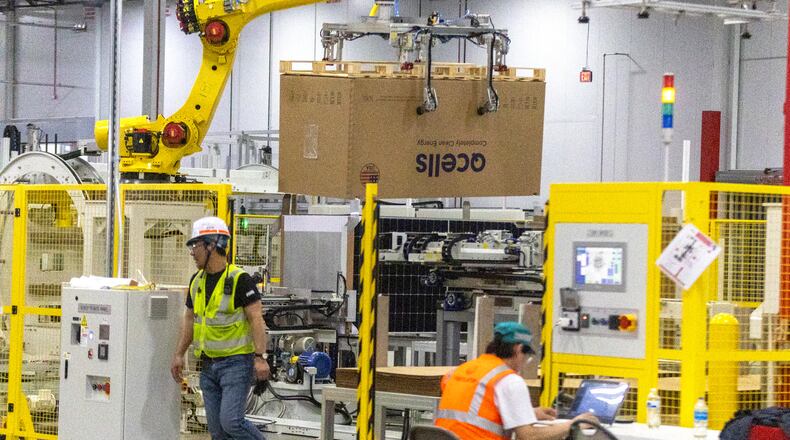President-elect Donald Trump’s nomination of Chris Wright as secretary of Energy and North Dakota Gov. Doug Burgum as secretary of the Interior places two staunch oil and gas supporters at the helm of America’s energy policy. Wright, chief executive of Liberty Energy, leads one of North America’s largest hydraulic fracturing companies, a technology that unlocked oil and gas from shale formations and helped make Burgum’s North Dakota become one of the nation’s top producers. But North Dakota isn’t just a major fossil fuel producer. It’s also a renewable energy powerhouse, where wind energy alone provides more than a third of the state’s electric power. North Dakota has also pursued carbon capture projects, hydrogen production and various other energy technologies.
Burgum’s dual role, which will include chairing a newly established National Energy Council, grants him significant influence over the nation’s energy strategy. He should use his experience as governor of a state that has implemented an “all of the above” energy approach to guide the incoming administration’s and the new Republican Congress’ response to misguided calls to repeal the Inflation Reduction Act. Reversing this law would be a strategic misstep that would weaken America’s energy security and hinder our domestic manufacturing and job growth.
Credit: White House
Credit: White House
Across America — particularly across Republican and rural communities — dormant industrial sites are being revitalized into cutting-edge clean energy hubs because of significant investments from the market-driven IRA. Novonix is transforming an old factory in Chattanooga, Tennessee, into an advanced battery plant. In Georgia, Qcells is building the largest solar manufacturing complex in U.S. history. And in Weirton, West Virginia, a shuttered steel mill is now the site of Form Energy’s grid-scale battery factory.
These are not isolated business decisions; they represent an industrial renaissance driven by the IRA, the largest climate and clean energy legislation in U.S. history. But this law is much more than that. The IRA is also the most ambitious industrial policy the United States has seen in decades.
It is already creating an American manufacturing and a job creation boom nationwide. In just two years, businesses have announced $130 billion in funding for nearly 340 major clean energy projects across the country, according to Environmental Entrepreneurs.
The law also addresses the critical issue of competition: the technologies we pioneered in the United States — from advanced batteries to solar panels — are now largely manufactured overseas, especially in China. Over time we ceded control of entire supply chains and eroded our industrial base. But because of the IRA, that is changing.
The IRA is rebuilding these domestic supply chains by tying tax credits to U.S. sourcing requirements, creating a complete production ecosystem on American soil. Consider the electric vehicle battery industry: Novonix in Tennessee is expanding its advanced battery manufacturing facilities through IRA incentives, focusing on critical components for lithium-ion and grid storage batteries. To supply these manufacturers, Livent has constructed North America’s first new lithium hydroxide production facility in over a decade in North Carolina. Supporting this processing capacity, Albemarle plans to reopen its Kings Mountain lithium mine in North Carolina — establishing a complete domestic supply chain from raw materials to finished batteries.
The IRA’s approach relies on strategic market incentives rather than top-down mandates. It rewards domestic production of critical energy technologies like hydrogen, nuclear, solar and geothermal, with enhanced credits for sourcing materials domestically. Beyond manufacturing, it also incentivizes clean electricity generation, decarbonizing our grid while boosting our energy security.
The IRA’s market-driven model contrasts sharply with past attempts at climate legislation, which often relied on carbon taxes or cap-and-trade systems that penalized polluters. Instead, the IRA empowers industry to lead the clean energy transition with time limited government support, not permanent subsidies like those enjoyed by the fossil fuel industry.
Despite no Republican support for the legislation, the Biden administration implemented the IRA through an apolitical process. The results speak for themselves: Republican districts have received three times as much clean energy investment as Democratic ones. That’s why 18 Republican House members recently urged House Speaker Mike Johnson, R-La., not to dismantle the IRA, stating, “Energy tax credits have spurred innovation, incentivized investment, and created good jobs across the country — including in many districts represented by our conference.”
The stakes couldn’t be higher. Without these incentives, the United States was losing the global race for clean energy manufacturing. Now, we are turning the tide. Communities across the nation are becoming hubs of innovation and economic growth.
During World War II, American factories worked around the clock, fueling the nation’s war effort. Today, those same communities are mobilizing again — this time to build the technologies of our clean energy future. The new administration and Congress face a choice: Will we honor their commitment to rebuilding our industrial base or will we abandon them once more, hollowing out communities and stalling our industrial revival?
The answer should be clear: This is our moment to secure America’s economic leadership for generations to come by enabling the IRA to continue to support an industrial boom nationwide.
Ali Nouri served as deputy assistant to President Joe Biden for legislative affairs and as an assistant secretary for congressional and intergovernmental affairs at the U.S. Department of Energy. He is currently a lecturer at Princeton University.
About the Author
Keep Reading
The Latest
Featured


